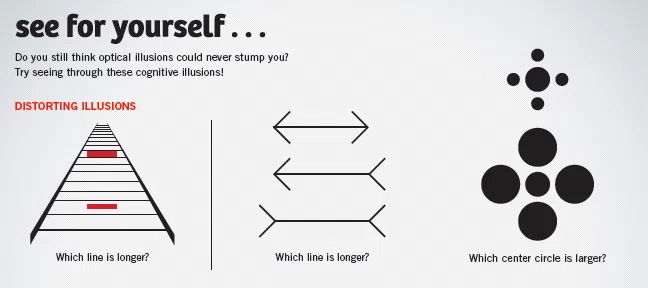Optical Illusions
Our brains use our sense of sight to interpret the world around us. So what happens when we see optical illusions? Optical illusions occur when our vision tricks our brains into interpreting information in surprising, sometimes wrong, ways. Different people might look at the same optical illusion and reach different conclusions about it, since their brains interpret the same information in different ways.
Would you like to try out some fun optical illusions?1 Invite some friends to look at these, and see how many interpret the illusions differently.

[Editor’s Note: Adapted from an article by Heather Brinson Bruce, “Experiment: What You See Isn’t Always What You Get,” Answers, April–June 2012.]
So how do you know if your brain is interpreting information the correct way? In the case of the above illusions, you may need to measure objects with a ruler to help you interpret the information.
While these illusions are harmless enough, and can even encourage brain activity, they remind us that we must be wary. Since our mind automatically fills in the gaps, sometimes it can be wrong. We cannot rely on our own limited experiences and perspective to accurately fill in all the gaps.
That is why God has given us invaluable resources, through His Holy Spirit and His Word, to begin to see the world as He sees it (as it really is). That’s why He can say, “Be transformed by the renewing of your mind, that you may prove what is that good and acceptable and perfect will of God” (Romans 12:2).2
Do you have questions about the world around us? You can find biblical answers. The Bible gives us a wealth of information about God, history, how we should live our lives, how to spend eternity with Jesus, and much more!
Footnotes
- Heather Brinson Bruce, “Experiment: What You See Isn’t Always What You Get,” Answers, April–June 2012, 40–41, www.answersingenesis.org/human-body/eyes/experiment-what-you-see-isnt-always-what-you-get/.
- Ibid.
Recommended Resources
- © 2025 Answers in Genesis
- Privacy Policy
- Contact
- About

